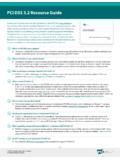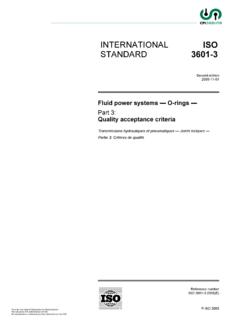Transcription of Edited by Rusty Russell Daniel Quinlan Christopher Yeoh
1 filesystem hierarchy StandardFilesystem hierarchy Standard GroupEdited byRusty RussellDaniel QuinlanChristopher YeohFilesystem hierarchy Standardby filesystem hierarchy Standard GroupEdited by Rusty Russell , Daniel Quinlan , and Christopher YeohPublished January 28 2004 Copyright 1994-2004 Daniel QuinlanCopyright 2001-2004 Paul Rusty RussellCopyright 2003-2004 Christopher YeohThis standard consists of a set of requirements and guidelines for file and directory placement under UNIX-likeoperating systems. The guidelines are intended to support interoperability of applications, system administrationtools, development tools, and scripts as well as greater uniformity of documentation for these trademarks and copyrights are owned by their owners, unless specifically noted otherwise. Use of a term in this document should not beregarded as affecting the validity of any trademark or service is granted to make and distribute verbatim copies of this standard provided the copyright and this permission notice are preservedon all is granted to copy and distribute modified versions of this standard under the conditions for verbatim copying, provided also thatthe title page is labeled as modified including a reference to the original standard, provided that information on retrieving the originalstandard is included, and provided that the entire resulting derived work is distributed under the terms of a permission notice identical to is granted to copy and distribute translations of this standard into another language, under the above conditions for modifiedversions, except that this permission notice may be stated in a translation approved by the copyright of Contents1.
2 The The Root Specific /bin : Essential user command binaries (for use by all users).. Specific /boot : Static files of the boot Specific /dev : Device Specific /etc : Host-specific system Specific /etc/opt : Configuration files for /etc/X11 : Configuration for the X Window System (optional).. Specific /etc/sgml : Configuration files for SGML (optional).. /etc/xml : Configuration files for XML (optional).. /home : User home directories (optional).. /lib : Essential shared libraries and kernel Specific /lib<qual> : Alternate format essential shared libraries (optional).. /media : Mount point for removeable Specific /mnt : Mount point for a temporarily mounted /opt : Add-on application software /root : Home directory for the root user (optional).. /sbin : System Specific /srv : Data for services provided by this /tmp : Temporary The /usr Specific /usr/X11R6 : X Window System, Version 11 Release 6 (optional).
3 Specific /usr/bin : Most user Specific /usr/include : Directory for standard include Specific /usr/lib : Libraries for programming and Specific /usr/lib<qual> : Alternate format libraries (optional).. /usr/local : Local Specific /usr/ /usr/sbin : Non-essential standard system /usr/share : Architecture-independent Specific /usr/share/dict : Word lists (optional).. Specific /usr/share/man : Manual Specific /usr/share/misc : Miscellaneous architecture-independent Specific /usr/share/sgml : SGML data (optional).. Specific /usr/share/xml : XML data (optional).. Specific /usr/src : Source code (optional).. The /var Specific /var/account : Process accounting logs (optional).. /var/cache : Application cache Specific /var/cache/fonts : Locally-generated fonts (optional).. Specific /var/cache/man : Locally-formatted manual pages (optional).
4 /var/crash : System crash dumps (optional).. /var/games : Variable game data (optional).. /var/lib : Variable state Specific /var/lib/<editor> : Editor backup files and state (optional).. /var/lib/hwclock : State directory for hwclock (optional).. /var/lib/misc : Miscellaneous variable /var/lock : Lock /var/log : Log files and Specific /var/mail : User mailbox files (optional).. /var/opt : Variable data for /var/run : Run-time variable /var/spool : Application spool Specific /var/spool/lpd : Line-printer daemon print queues (optional).. Specific /var/spool/rwho : Rwhod files (optional).. /var/tmp : Temporary files preserved between system /var/yp : Network Information Service (NIS) database files (optional).. Operating System Specific / : Root /bin : Essential user command binaries (for use by all users).. /dev : Devices and special /etc : Host-specific system /lib64 and /lib32 : 64/32-bit libraries (architecture dependent).
5 /proc : Kernel and process information virtual /sbin : Essential system /usr/include : Header files included by C /usr/src : Source /var/spool/cron : cron and at The FHS mailing Background of the General 1. PurposeThis standard enables: Software to predict the location of installed files and directories, and Users to predict the location of installed files and do this by: Specifying guiding principles for each area of the filesystem , Specifying the minimum files and directories required, Enumerating exceptions to the principles, and Enumerating specific cases where there has been historical FHS document is used by: Independent software suppliers to create applications which are FHS compliant, and work with distributionswhich are FHS complaint, OS creators to provide systems which are FHS compliant, and Users to understand and maintain the FHS compliance of a FHS document has a limited scope: Local placement of local files is a local issue, so FHS does not attempt to usurp system administrators.
6 FHS addresses issues where file placements need to be coordinated between multiple parties such as localsites, distributions, applications, documentation, ConventionsWe recommend that you read a typeset version of this document rather than the plain text version. In the typesetversion, the names of files and directories are displayed in a constant-width of filenames that vary are represented by a description of the contents enclosed in "<" and ">"characters,<thus>. Electronic mail addresses are also enclosed in "<" and ">" but are shown in the components of filenames are enclosed in "[" and "]" characters and may be combined with the "<" and">" convention. For example, if a filename is allowed to occur either with or without an extension, it might berepresented by<filename>[.<extension>].Variable substrings of directory names and filenames are indicated by "*".The sections of the text marked asRationaleare explanatory and are 2.
7 The FilesystemThis standard assumes that the operating system underlying an FHS-compliant file system supports the samebasic security features found in most UNIX is possible to define two independent distinctions among files: shareable vs. unshareable and variable vs. general, files that differ in either of these respects should be located in different directories. This makes it easyto store files with different usage characteristics on different filesystems."Shareable" files are those that can be stored on one host and used on others. "Unshareable" files are those thatare not shareable. For example, the files in user home directories are shareable whereas device lock files are not."Static" files include binaries, libraries, documentation files and other files that do not change without systemadministrator intervention. "Variable" files are files that are not files can be stored on one host and used on several others.
8 Typically, however, not all files in thefilesystem hierarchy are shareable and so each system has local storage containing at least its unshareablefiles. It is convenient if all the files a system requires that are stored on a foreign host can be made availableby mounting one or a few directories from the foreign and variable files should be segregated because static files, unlike variable files, can be stored onread-only media and do not need to be backed up on the same schedule as variable UNIX-like filesystem hierarchies contained both static and variable files under both/ order to realize the advantages mentioned above, the/varhierarchy was created and all variable fileswere transferred from/usrto/var. Consequently/usrcan now be mounted read-only (if it is a separatefilesystem). Variable files have been transferred from/etcto/varover a longer period as technology is an example of a FHS-compliant system.
9 (Other FHS-compliant layouts are possible.)shareableunshareablestatic/usr /etc/opt/bootvariable/var/mail/var/run/v ar/spool/news/var/lock2 Chapter 3. The Root PurposeThe contents of the root filesystem must be adequate to boot, restore, recover, and/or repair the system. To boot a system, enough must be present on the root partition to mount other filesystems. This includesutilities, configuration, boot loader information, and other essential start-up ,/opt, and/vararedesigned such that they may be located on other partitions or filesystems. To enable recovery and/or repair of a system, those utilities needed by an experienced maintainer to diagnoseand reconstruct a damaged system must be present on the root filesystem . To restore a system, those utilities needed to restore from system backups (on floppy, tape, etc.) must bepresent on the root primary concern used to balance these considerations, which favor placing many things on the rootfilesystem, is the goal of keeping root as small as reasonably possible.
10 For several reasons, it is desirable tokeep the root filesystem small: It is occasionally mounted from very small media. The root filesystem contains many system-specific configuration files. Possible examples include a kernelthat is specific to the system, a specific hostname, etc. This means that the root filesystem isn t alwaysshareable between networked systems. Keeping it small on servers in networked systems minimizes theamount of lost space for areas of unshareable files. It also allows workstations with smaller local harddrives. While you may have the root filesystem on a large partition, and may be able to fill it to your heart scontent, there will be people with smaller partitions. If you have more files installed, you may findincompatibilities with other systems using root filesystems on smaller partitions. If you are a developerthen you may be turning your assumption into a problem for a large number of users.







